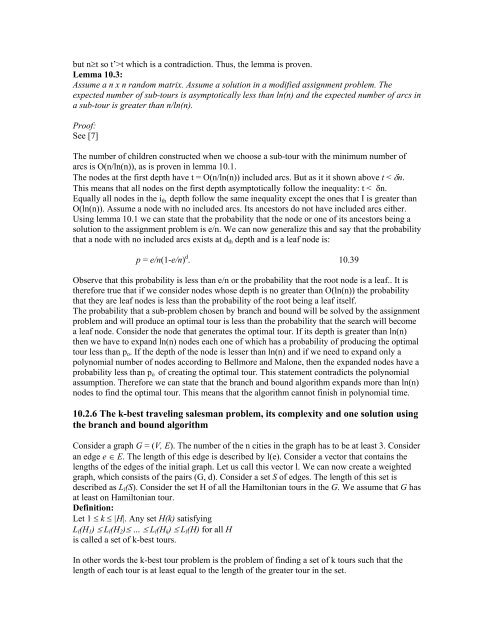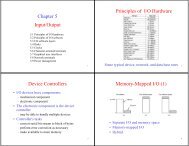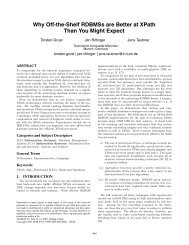Chapter 10 The Traveling Salesman Problem
Chapter 10 The Traveling Salesman Problem
Chapter 10 The Traveling Salesman Problem
You also want an ePaper? Increase the reach of your titles
YUMPU automatically turns print PDFs into web optimized ePapers that Google loves.
ut n≥t so t’>t which is a contradiction. Thus, the lemma is proven.<br />
Lemma <strong>10</strong>.3:<br />
Assume a n x n random matrix. Assume a solution in a modified assignment problem. <strong>The</strong><br />
expected number of sub-tours is asymptotically less than ln(n) and the expected number of arcs in<br />
a sub-tour is greater than n/ln(n).<br />
Proof:<br />
See [7]<br />
<strong>The</strong> number of children constructed when we choose a sub-tour with the minimum number of<br />
arcs is O(n/ln(n)), as is proven in lemma <strong>10</strong>.1.<br />
<strong>The</strong> nodes at the first depth have t = O(n/ln(n)) included arcs. But as it it shown above t < δn.<br />
This means that all nodes on the first depth asymptotically follow the inequality: t < δn.<br />
Equally all nodes in the ith depth follow the same inequality except the ones that I is greater than<br />
O(ln(n)). Assume a node with no included arcs. Its ancestors do not have included arcs either.<br />
Using lemma <strong>10</strong>.1 we can state that the probability that the node or one of its ancestors being a<br />
solution to the assignment problem is e/n. We can now generalize this and say that the probability<br />
that a node with no included arcs exists at dth depth and is a leaf node is:<br />
p = e/n(1-e/n) d . <strong>10</strong>.39<br />
Observe that this probability is less than e/n or the probability that the root node is a leaf.. It is<br />
therefore true that if we consider nodes whose depth is no greater than O(ln(n)) the probability<br />
that they are leaf nodes is less than the probability of the root being a leaf itself.<br />
<strong>The</strong> probability that a sub-problem chosen by branch and bound will be solved by the assignment<br />
problem and will produce an optimal tour is less than the probability that the search will become<br />
a leaf node. Consider the node that generates the optimal tour. If its depth is greater than ln(n)<br />
then we have to expand ln(n) nodes each one of which has a probability of producing the optimal<br />
tour less than po. If the depth of the node is lesser than ln(n) and if we need to expand only a<br />
polynomial number of nodes according to Bellmore and Malone, then the expanded nodes have a<br />
probability less than po of creating the optimal tour. This statement contradicts the polynomial<br />
assumption. <strong>The</strong>refore we can state that the branch and bound algorithm expands more than ln(n)<br />
nodes to find the optimal tour. This means that the algorithm cannot finish in polynomial time.<br />
<strong>10</strong>.2.6 <strong>The</strong> k-best traveling salesman problem, its complexity and one solution using<br />
the branch and bound algorithm<br />
Consider a graph G = (V, E). <strong>The</strong> number of the n cities in the graph has to be at least 3. Consider<br />
an edge e ∈ E. <strong>The</strong> length of this edge is described by l(e). Consider a vector that contains the<br />
lengths of the edges of the initial graph. Let us call this vector l. We can now create a weighted<br />
graph, which consists of the pairs (G, d). Consider a set S of edges. <strong>The</strong> length of this set is<br />
described as Ll(S). Consider the set H of all the Hamiltonian tours in the G. We assume that G has<br />
at least on Hamiltonian tour.<br />
Definition:<br />
Let 1 ≤ k ≤ |H|. Any set H(k) satisfying<br />
Ll(H1) ≤ Ll(H2)≤ … ≤ Ll(Hk) ≤ Ll(H) for all H<br />
is called a set of k-best tours.<br />
In other words the k-best tour problem is the problem of finding a set of k tours such that the<br />
length of each tour is at least equal to the length of the greater tour in the set.






